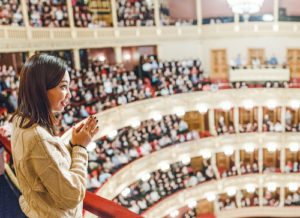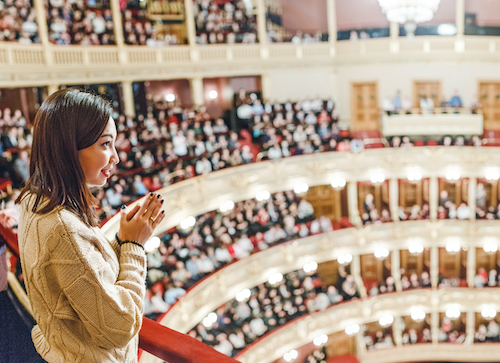 The focus of this year’s Collaboration and Innovation class at the Yale School of Music was engaging audiences through classical music. We had three project groups exploring different ways to expand the classical music audience using different interactive strategies. The culmination of these projects was our final class where each group presents its project. Let’s see how each group tackled the problem of engaging today’s audience with three very different solutions.
The focus of this year’s Collaboration and Innovation class at the Yale School of Music was engaging audiences through classical music. We had three project groups exploring different ways to expand the classical music audience using different interactive strategies. The culmination of these projects was our final class where each group presents its project. Let’s see how each group tackled the problem of engaging today’s audience with three very different solutions.
-
Engaging Today’s Audience Through An Interactive Concert for Our Peers
This group set out to solve the problem of engaging today’s audience with an interactive concert for their peers. They sought to create an informal event that was free, convenient and time efficient for non music graduate students at Yale. The project explored how music could be the starting point for conversations between students about their experience. The goal was to create a greater sense of community by helping students to be comfortable interacting with each other. To assess the success of the event, the students proposed to measure their audience’s reactions to the concert. They planned to record the audience’s moods before and after the event by adapting the Mood Meter app, a tool developed by the Yale Center for Emotional Intelligence.
This group seized upon the idea of building on an existing Thursday night event series at the Yale School of Management (SOM) known as “Closing Bell”. By collaborating with SOM, our students had the benefit of a built-in audience and an existing venue. It also simplified their marketing efforts since the SOM students were accustomed to attending Closing Bell. As part of their project development, our students conducted their audience interviews and tested their concert prototype at SOM to gauge their reaction to the event. The feedback reinforced the project idea of using music to create community. Ourstudents were excited to present their interactive concert at the final Closing Bell event of the semester.
It all seemed so easy until….
Just before Thanksgiving break, SOM advised my students that Closing Bell was no longer available to them. This startling announcement thoroughly upended their project. With only two weeks left in the semester, the students had to find an alternative venue on a different date and do their own marketing. Fortunately, I was able to connect them with the head of one of Yale’s undergraduate residential colleges who agreed to host the event there.
In addition, the timing did not work out in their favor. The only available date was the last day of classes, not the ideal time for the busy undergraduates of Yale. Moreover, due to the fact that Thanksgiving was late this year, the students had only one week before the event to market and advertise their concert. As a result, no undergraduates attended the concert.
Notwithstanding these impediments, our students were able to recover very quickly and demonstrated their flexibility to regroup. With no undergraduates in sight, the performers began messaging their friends at the Yale School of Music and assembled an audience. As a result, the project group had to change their interactive element since they were performing for an existing community. Instead, the student created an event that combined music with audience dialogue about the music in a relaxed salon environment.
The event turned out to be an excellent learning experience about how to plan, curate and organize a concert. The students learned firsthand the importance of communicating and interacting with the audience. The event also taught the students the importance of marketing and advertising in assembling an audience and in tailoring the message to the particular audience. They ultimately learned the value of engaging today’s audience by creating a relaxed event that encouraged dialogue between the performers and the audience.
-
Engaging Today’s Audience Through Music and Wellness
This project group was interested in exploring the intersection between classical music and the wellness industry. Their focus was how to alleviate the stress that musicians experience in meeting the high standards of excellence of the classical music profession.
The students decided to create an intimate and inclusive classical music performance for students at Yale School of Music. Along with a musical passage, each performer was invited to tell a personal story about themselves and their music. The tag-line for the event was “Sofar Sounds meets Slam Poetry meets an AA meeting” .
The event was presented in the student lounge. It featured 8 performers who played a piece of music and told a story about themselves. The group invited the audience to relax while listening to the performers. To enhance the relaxing, stress-free ambience, the event included food and drinks. In addition, the group provided the audience with art supplies so that they could draw or write while listening to the music.
The group was interested in assessing the success of their event through use of the Mood Meter. They invited the audience and the performers to record their moods on a poster before and after the event. Not surprisingly, everyone felt calmer and happier after the event!
The group did an excellent job of humanizing the musicians and encouraging them to share their challenges and their stories in a safe space. The innovation of this project was to use classical music as a source of stress relief for the very people who are making the music. They learned the value of engaging today’s audience using empathy to create a bond with the community and promote inner peace and wellness.
-
Engaging Today’s Audience Through A Choose Your Own Adventure Opera
The third project group set out to create an audience-participatory ”choose your own adventure” opera for an audience of young people with little or no opera experience. The goal was to help the audience experience beauty and joy and thereby embrace opera throughout their lives.
Initially, the students thought about working with a composer to write an original interactive opera. They were concerned about the amount of time that this would take. They also worried that it would be hard for the singers to adapt quickly to audience’s choices and to be flexible if things went off script. However, after using a variety of brainstorming tools, they came up with another idea: to tell a familiar story using existing opera arias and invite the audience’s participation by designing different points at which the audience could intervene to decide on the direction of the story.
The students thus created an operetta using the familiar story of Little Red Riding Hood encountering the wolf in the forest on her way to see her sick grandmother. They performed a 15-minute scene in our last class to an audience consisting of their fellow students, myself and our project advisors. It was a smashing success.
The innovation of this project was to tell the story by adapting famous opera arias from Puccini’s La Bohème, Faust by Charles Gounod and Mozart’s Don Giovanni. Moreover, to enhance the appeal of opera to audiences who are new to opera, they set the arias in English. At two points, the audience was invited to vote on which direction to take the story. The singers responded accordingly, singing different arias depending on the audience’s vote. Using the familiar arias was a great way to engage the audience and gives them a taste of the beauty and emotional content of opera.
We all cheered for the singers and felt that this type of opera could be a great way to introduce millennial audiences to opera and engage them through a fun and emotionally satisfying experience. We saw the potential to attract new audiences to opera as well as creating another potential revenue stream for singers. The group thus learned the value of engaging today’s audiences by inviting them into story and showing them the beauty and power of opera.

